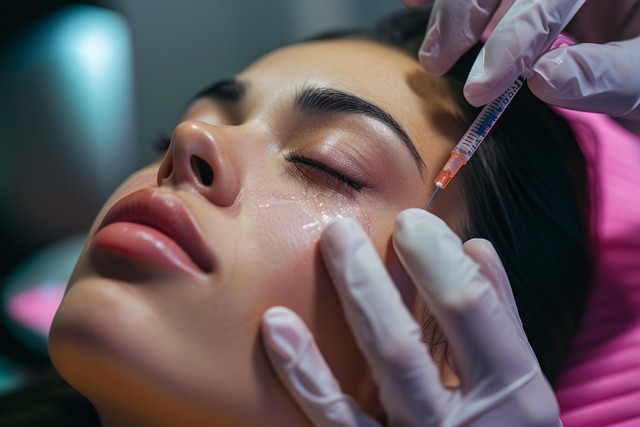Professional Botox treatments use a bacteria-derived neurotoxin to temporarily block nerve signals, preventing muscle contractions and wrinkle formation for a smoother, more youthful appearance. Safe and effective with minimal downtime, these treatments are a popular, precise solution for reducing fine lines and crow's feet. Dermal fillers, an alternative, offer volume restoration and collagen stimulation using hyaluronic acid or natural materials, appealing to those seeking deeper wrinkle reduction with immediate results lasting up to 2 years. The choice between them depends on individual needs: Botox for dynamic wrinkles and dermal fillers for static wrinkles and volume loss. Both treatments are safe when administered by qualified professionals, with Botox potentially more cost-effective due to its longer duration.
“Uncover the eternal youth you’ve always wanted with a detailed comparison between two popular skin rejuvenation treatments—Botox for wrinkles and dermal fillers. This comprehensive guide delves into the science behind these non-invasive procedures, exploring their unique benefits and potential risks.
From understanding the mechanics of Botox’s wrinkle-reducing effects to evaluating the transformative power of dermal fillers, we weigh the pros and cons of each. Discover the factors that influence your choice between these top anti-aging solutions, including safety, cost, and maintenance considerations for professional Botox treatments.”
Understanding Botox: A Popular Anti-Aging Treatment

Botox, a neurotoxin derived from bacteria, has established itself as a popular and effective anti-aging treatment for many years. When administered by professional Botox treatments, it works by blocking nerve signals to specific muscles, preventing them from contracting and causing wrinkles. This non-surgical procedure offers a temporary yet significant reduction in fine lines and crow’s feet, providing a smoother and more youthful appearance.
The appeal of Botox lies not only in its ability to minimize existing wrinkles but also in its preventive measure. Regular treatments can help delay the formation of new lines, allowing individuals to maintain a youthful glow for longer. Moreover, professional Botox treatments are known for their precision, ensuring minimal downtime and natural-looking results that enhance one’s overall appearance without appearing overly dramatic or artificial.
The Science Behind Botox's Wrinkle-Reducing Effects

Botox, a protein derived from bacteria, has been expertly crafted into a powerful tool for combating wrinkles and enhancing facial aesthetics. Its wrinkle-reducing effects stem from its ability to block nerve signals that trigger muscle contractions. In response to Botox injections, muscles relax, preventing the repeated micro-deformations that lead to dynamic wrinkles. Over time, this results in a noticeable smoothing of the skin’s surface. Professional Botox treatments typically target specific areas of concern, offering a precise and tailored approach to anti-aging.
The science behind Botox’s effectiveness is well-established, with numerous studies backing its safety and efficacy. It has been extensively used for decades, refining its application techniques and formulations. Today, advanced injection methods ensure minimal discomfort and faster recovery times, making professional Botox treatments increasingly accessible and popular choices for those seeking youthful-looking skin.
Benefits and Potential Risks of Professional Botox Treatments

Professional Botox treatments offer a multitude of benefits for those seeking to reduce the appearance of wrinkles and fine lines. One of the key advantages is its ability to relax muscles, which leads to a significant diminution of dynamic wrinkles, especially around the eyes and forehead. This non-invasive procedure provides immediate results, offering a youthful glow without any lengthy recovery time. It’s particularly appealing for individuals who desire a natural, subtle enhancement.
However, like any cosmetic treatment, Professional Botox also carries potential risks. Temporary side effects such as temporary muscle weakness, headaches, or mild bruising at the injection site may occur. It’s essential for patients to choose qualified professionals who use sterile techniques to minimise these risks. Additionally, understanding that results vary from person to person is crucial, as individual factors can influence how long the treatment’s effects last.
Dermal Fillers: An Alternative Solution for Skin Rejuvenation

Dermal fillers offer a popular alternative to professional Botox treatments for those seeking skin rejuvenation. Unlike Botox, which works by temporarily paralyzing muscles to reduce dynamic wrinkles, dermal fillers enhance volume and smooth out fine lines and wrinkles from the surface of the skin. These injections are composed of hyaluronic acid, a natural substance that attracts moisture to the skin, plumping it up and providing immediate results.
This non-invasive procedure is quick and relatively painless, making it an attractive option for those looking for a more subtle and natural-looking enhancement compared to Botox’s more pronounced effects. Dermal fillers can be used in various areas of the face, including the cheeks, jawline, and brow, providing a youthful glow and definition without the need for surgical procedures.
How Dermal Fillers Work to Smooth Fine Lines and Wrinkles

Dermal fillers are a popular alternative to professional Botox treatments for those seeking to smooth fine lines and wrinkles. These injectable substances, often made from hyaluronic acid or other natural materials, add volume to the skin by filling in the spaces between skin cells and stimulating collagen production. By plumping up the skin, dermal fillers help to reduce the appearance of wrinkles, especially in areas like the forehead, cheeks, and around the mouth.
When a dermatologist or cosmetic specialist administers dermal fillers, they target specific problem areas, providing a tailored treatment plan. The procedure is typically quick, with minimal downtime, and offers immediate results that can last for several months, depending on the product used. This non-invasive approach to anti-aging makes dermal fillers an attractive option for those who want to achieve a youthful complexion without the extensive recovery period associated with surgical procedures.
Comparing Results: Botox vs Dermal Fillers

When comparing professional Botox treatments against dermal fillers, it’s important to understand their distinct effects on skin rejuvenation. Botox is a neurotoxin that relaxes muscles, reducing dynamic wrinkles caused by facial expressions. It’s ideal for fine lines and crow’s feet, offering a natural, subtle enhancement. On the other hand, dermal fillers enhance volume and contour by plugging gaps in the skin with hyaluronic acid or collagen-based substances. They’re better suited for deeper static wrinkles and areas requiring more pronounced volume restoration.
The results of Botox tend to be temporary, lasting 3-6 months, whereas dermal fillers can provide longer-lasting improvements, often up to 2 years or more. While Botox focuses on preventing muscle contraction, leading to smoother skin, dermal fillers plump the skin from the outside in, giving it a softer, more youthful appearance. Both procedures have their merits, and the choice between them depends on an individual’s specific concerns and desired outcome.
Choosing the Right Treatment: Factors to Consider

When deciding between Botox for wrinkles and dermal fillers, it’s crucial to consider several factors that will determine which treatment is best suited for your individual needs. One key aspect is understanding the mechanism of action for each. Botox, a popular choice for professional Botox treatments, works by blocking nerve signals to the muscles, temporarily paralyzing them and preventing contraction, which smooths out wrinkles. On the other hand, dermal fillers enhance skin volume and elasticity by injecting a substance beneath the surface to fill in depressed areas.
Other considerations include your skin type, desired results, and maintenance requirements. For instance, Botox is ideal for fine lines and dynamic wrinkles caused by facial expressions, while dermal fillers are more suitable for deep facial wrinkles and loss of volume. Maintenance schedules also differ; Botox treatments typically last 3-6 months, whereas dermal filler effects can last anywhere from 6 months to several years, depending on the product used.
Safety, Cost, and Maintenance: A Comprehensive Look

When considering cosmetic procedures for skin rejuvenation, safety is paramount. Both Botox and dermal fillers have established their safety profiles over time, but it’s crucial to opt for professional treatments from licensed practitioners. Botox, renowned for its ability to smooth fine lines and wrinkles, is generally well-tolerated when administered correctly. Dermal fillers, on the other hand, offer a volumizing effect, making them ideal for addressing deeper creases and enhancing facial contours.
Cost varies between these two popular treatments, with dermal fillers often carrying a higher price tag initially. However, in terms of maintenance, Botox typically requires fewer follow-up sessions compared to fillers. Professional Botox treatments can provide results that last 3–6 months, while filler effects may last longer (up to 2 years), depending on the type used. This difference influences long-term costs, with Botox potentially offering a more economical approach for sustained results.
